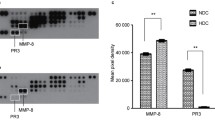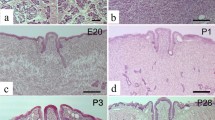Summary
The tripeptide substrated-val-leu-arg-4-methoxy-2-naphthylamine gave a precise localization of reaction product in cryostat sections of aldehyde-fixed salivary glands from a number of species, with Fast Blue B as the capture reagent. In submandibular glands, there was strong staining of the granules in granular tubules of rats and hamsters and somewhat less in mice. Submandibular striated ducts showed variable periluminal staining in a finer granular form; it was abundant in guinea-pigs, strong in cats but somewhat less pronounced in dogs. Parotid glands contained less reactivity with none detectable in hamsters and guinea-pigs. In the rabbit, neither gland showed any reaction. Mast cells were densely stained in glands from cats and dogs; they were less reactive in rats and unstained in the other species.
The closely related 7-amino-4-trifluoromethylcoumarin derivative of the tripeptide has been found highly satisfactory for assessing activity in submandibular saliva from cats. Preliminary functional studies indicate that an extensive rapid secretion of enzyme occurs into saliva on sympathetic stimulation, with a corresponding depletion of reactive material from the striated ducts in tissue sections. Far less mobilization of enzyme occurs into saliva on parasympathetic stimulation with no obvious change in the histochemical reaction of striated ducts. The possible significance of these findings in cats is discussed.
Extensive qualitative and quantitative studies are required to evaluate enzyme and substrate specificities in each species. Nevertheless, derivatives ofd-val-leu-arg offer great promise for the functional testing of kallikrein-like reactivity both by histochemical means on cells and biochemically in their secretions.
Similar content being viewed by others
References
Al-Gailani, M., Garrett, J. R., Kidd, A., Kyriacou, K. &Leite, P. (1980) Localisation of esteroproteases in ‘resting’ salivary glands from different species and the effects of the organophosphorus inhibitor E600.Histochemistry 66, 59–74.
Barton, S., Sanders, E. J., Schachter, M. &Uddin, M. (1975) Autonomic nerve stimulation, kallikrein content and acinar cell granules of the cat's submandibular gland.J. Physiol., Lond. 251, 363–9.
Beilenson, S., Schachter, M. &Smaje, L. H. (1968) Secretion of kallikrein and its role in vasodilatation in the submaxillary gland.J. Physiol., Lond. 199, 303–17.
Fiedler, F., Geiger, R., Hirschauer, C. &Leysath, G. (1978) Peptide esters and nitroanilides as substrates for the assay of human urinary kallikrein.Z. Physiol. Chem. 359, 1667–73.
Frey, E. K., Kraut, H. &Werle, E. (1968)Das Kallikrein-Kinin-System und seine Inhibitoren. Stuttgart: Enke.
Fritz, H., Kruck, J., Rüsse, I. &Liebich, H. G. (1979) Immunofluorescence studies indicate that the basic trypsin-kallikrein-inhibitor of bovine organs (Trasolyl) originates from mast cells.Z. Physiol. Chem. 360, 437–44.
Fukuoka, Y., Hojima, Y., Miyaura, S. &Moriwaki, C. (1979) Purification of cat submaxillary kallikrein.J. Biochem. 85, 549–57.
Garrett, J. R. &Kidd, A. (1975) Effects of nerve stimulation and denervation on secretory material in submandibular striated duct cells of cats, and the possible role of these cells in the secretion of salivary kallikrein.Cell Tiss. Res. 161, 71–84.
Gossrau, R. (1981) Investigation of proteinases in the digestive tract using 4-methoxy-2-naphthylamine (MNA) substrates.J. Histochem. Cytochem. 29, 464–80.
Gossrau, R. (1982) Localization and regulation of proteolytic enzymes in salivary glands. InMolecular and Cellular Regulation of Enzyme Activity. Halle (in press).
Hojima, Y., Maranda, B., Moriwaki, C. &Schachter, M. (1977) Direct evidence for the location of kallikrein in the striated ducts of the cat's submandibular gland by the use of specific antibody.J. Physiol., Lond. 268, 793–801.
Huseby, R. M. &Smith, R. E. (1980) Synthetic oligopeptide substrates — their diagnostic application in blood coagulation, fibrinolysis and other pathological states.Seminars Thrombosis Hemostasis 6, 173–314.
Karnovsky, M. J. (1965) A formaldehyde-glutaraldehyde fixative of high osmolality for use in electron microscopy.J. Cell Biol. 27, 137–8A.
Lojda, Z. (1981) Proteinases in pathology. Usefulness of histochemical methods.J. Histochem. Cytochem. 29, 481–93.
Maranda, B., Rodrigues, J. A. A., Schachter, M., Schnitka, T. K. &Weinberg, J. (1978) Studies on kallikrein in the duct systems of the salivary glands of the cat.J. Physiol., Lond. 276, 321–8.
Newball, H. H., Talamo, R. C. &Lichtenstein, L. M. (1975) Release of leukocyte kallikrein mediated by IgE.Nature, Lond. 254, 635–6.
Ørstavik, T. B., Brandtzaeg, P., Nustad, K. &Halvorsen, K. M. (1975) Cellular localization of kallikreins in rat submandibular and sublingual salivary glands.Acta histochem. 54, 183–92.
Ørstavik, T. B., Nustad, K. &Brandtzaeg, P. (1977) A biochemical and immunohistochemical study of kallikrein in normal and isoproterenol-stimulated rat salivary glands during post-natal development.Archs. oral Biol. 22, 495–502.
Pearson, K. W., Smith, R. E., Mitchell, A. R. &Bissel, E. R. (1981) Automated enzyme assays by use of a centrifugal analyzer with fluorescence detection.Clin. Chem. 27, 256–62.
Schachter, M. (1980) Kallikreins (kinogenases) — A group of serine proteases with bioregulatory actions.Pharmacol. Rev. 31, 1–17.
Schachter, M., Peret, M. W., Moriwaki, C. &Rodrigues, J. A. A. (1980) Localization of kallikrein in submandibular gland of cat, guinea-pig, dog, and man by the immunoperoxidase method.J. Histochem. Cytochem. 28, 1295–300.
Simson, J. A. V., Spicer, S. S., Chao, J., Grimm, L. &Margolius, H. S. (1979) Kallikrein localization in rodent salivary glands and kidney with the immunoglobulin-enzyme bridge technique.J. Histochem. Cytochem. 27, 1567–76.
Smith, R. E., Bissel, E. R., Mitchell, A. R. &Pearson, K. W. (1980) Direct photometric or fluorimetric assay of proteinases using substrates containing 7-amino-4-trifluorometyl-coumarin.Thrombosis Res. 17, 393–402.
Vogel, R. &Werle, E. (1970) Kallikrein inhibitors. InHandbook of Experimental Pharmacology Vol. 25,Bradykinin, Kallidin and Kallikrein (edited byErdos, E. G. andWilde, A. F.), pp. 213–49. Berlin, Heidelberg, New York: Springer Verlag.
Werle, E. &Von Roden, P. (1936) Über des Vorkommen von Kallikrein in den Speicheldrüsen und in Mundspeichel.Biochem. Z. 286, 213–9.
Author information
Authors and Affiliations
Rights and permissions
About this article
Cite this article
Garrett, J.R., Smith, R.E., Kidd, A. et al. Kallikrein-like activity in salivary glands using a new tripeptide substrate, including preliminary secretory studies and observations on mast cells. Histochem J 14, 967–979 (1982). https://doi.org/10.1007/BF01005237
Received:
Revised:
Issue Date:
DOI: https://doi.org/10.1007/BF01005237




